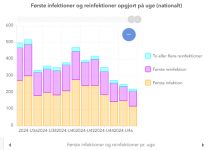Egg
Graduate Poster
- Joined
- Nov 22, 2007
- Messages
- 1,585
I was meaning reporting as in giving the public reports on what is going on, estimated case numbers etc. Generally, you have to look for this info.Case numbers are reported but only when tests are done by a medical center and most tests are not. Most people now test at home with a rapid test. They just isolate 5 days and if positive and older, they can call their doctor and get Paxlovid. None of these become cases. Not something new. This has been true since early 2022.
Mandatory Covid hospitalization reporting ceased May 1. It (and Flu reporting) will resume on Nov 1 for the expected winter season. As a result, only about 1/3 of hospitals report so the total number of hospitalizations is a big undercount. That's why the CDC reports hospitalizations per 100k people. This is relative to the service population so not affected by dropping mandatory reporting. If you look at those charts there was no sudden drop in May.
Are most people even home testing these days or isolating? The "expected winter season" is the sort of inaccurate information a lot of people believe about Covid - well, those who don't just think it's either entirely over or no worse than a cold now.

